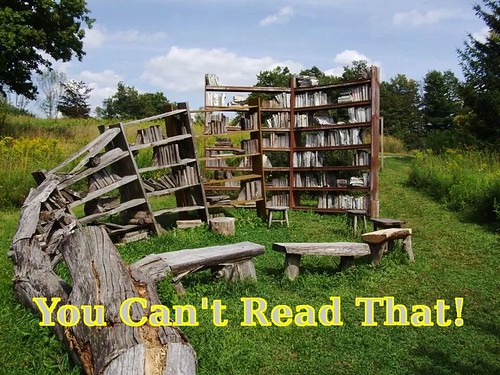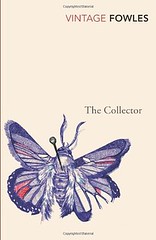You Can’t Read That! is a periodic post featuring banned book reviews and news roundups.

YCRT! News:
“Whether or not patterns like this are the result of co-ordination between would-be censors across the country is impossible to say. But there are moments, when a half-dozen or so challenges regarding race or LGBT content hit within a couple weeks, where you just have to ask ‘what is going on out there?’” Book bannings in US schools are on the rise.
Well, I’ll say it, and actually have been saying it for some time. It is a co-ordinated effort. Religious right parents, encouraged by groups such as Parents Against Bad Books in Schools and individual agents who travel around the country with alarmist Powerpoint presentations and who push a pro-censorship message via social media, are going after books with racial, politically progressive, and sexual — especially LGBT — content. They’ve been doing it for years.
I’ve discussed the trend in previous diaries. Here’s a one-entry summary from an earlier YCRT! column:
Worth another mention: The Political Agenda of the Morality Police. My only objection? The author doesn’t connect the dots tying widespread attempts to have books restricted or banned to organized right-wing Christianist activism. Here are some items I’ve covered in previous YCRT! columns:
- Censorship on the rise: US schools have banned more than 20 books this year (2011)
- Those challenging books find strength in numbers
- Tea Party moves to ban books
- Powerpoint presentation being shown to groups of conservative and religious parents around the country
- PABBIS: Parents Against Bad Books in Schools
The more I read news articles about challenges to school text and library books, educational videos, plays put on by drama departments, articles in student newspapers, or the very subjects of courses listed in elementary, secondary, and college curricula, the more I sense right-wing Christianist activism at work. Far from being isolated incidents of parents being shocked at something a child brings home from school, I believe these reports indicate an organized movement to force a specific Christian religious message on children.
Meanwhile, here are some resources for teachers and school librarians who want to fight back.
“Teens don’t read books like Anderson’s or Ness’s, Blume’s or Cormier’s, or any other books published as YA each year as how-to guides.” What are grown-ups afraid of in YA books?
When a county official wanted The Color Purple banned, the school superintendent responded with this letter.
Nothing better illustrates the arbitrary, capricious nature of official censorship than this list of books banned to Guantanamo Bay prisoners:
- Martin Amis: Money
- Richard Beckett: The New Dinkum Aussie Dictionary
- Lord Thomas Bingham: The Rule of Law
- Russell Brand: Booky Wook Two
- Professor Alan Dershowitz: Blasphemy: How the Religious Right is Hijacking our Declaration of Independence
- Fyodor Dostoyevsky: Crime & Punishment
- Frederick Douglass: The African American Slave
- Frederick Forsyth: The Kill List
- George Galloway: I’m Not the Only One
- John Grisham: The Innocent Man
- John Kampfner: Blair’s Wars
- EM Naguib: Puss in Boots, Cinderella, Jack & the Beanstalk, Beauty and the Beast
- Wilfred Owen: Futility
- John Pilger: Hidden Agendas
- William Shakespeare: The Merchant of Venice
- Clare Short: An Honourable Deception: New Labour, Iraq and the Misuse of Power
- Aleksandr Solzhenitsyn: Gulag Archipelago
- Clive Stafford Smith: Bad Men, Injustice
- Harriet Beecher Stowe: Uncle Tom’s Cabin
- Scott Turow: Presumed Innocent
I’m not sure I like the suppression of controversial books any better when it comes from the left. Ugh, here’s another incident!
YCRT! Banned Book Review:
 The Collector
The Collector
John Fowles
![]()
I didn’t realize John Fowles’ The Collector had been the target of a book banning campaign until after I’d read it. Sometime during 2013, parents in Pflugerville, Texas, tried to have the novel removed from an advanced placement English class reading list, citing profanity, sexual content, nudity, violence, horror, and content offensive to religious sensitivities. The school administrator at Hendrickson High School directed the teacher to allow an alternate reading assignment for students whose parents objected to The Collector.*
I read the book in December 2013. Here’s my review:
I don’t know whether The Collector is the granddaddy of pervy-creep-kidnaps-woman novels, as the jacket blurb implied, but it certainly sired copycats and is undoubtedly a distant ancestor of last year’s popular hit Gone Girl.
In Gone Girl we switch points of view between two protagonists, a husband and wife. In The Collector, we switch POVs between the kidnapper and his victim. I don’t know how far back this novelistic technique goes; I gather it was still somewhat novel in 1963 when John Fowles published The Collector.
For the first several chapters of The Collector, the kidnapper has the stage: he describes his life and frustrations, the careful planning and execution of the kidnapping, life with his victim during the initial weeks of her captivity. Halfway through the novel we begin reading the victim’s diary, which covers the same period. The resulting insight into both characters’ minds makes it a far richer story than if it had been told from just one side, of course.
As we read husband’s and wife’s inner thoughts in Gone Girl, we begin to suspect — and soon find it fully confirmed — that they’re hiding important things from each other and the world at large. That is the source of much of Gone Girl’s tension. One never suspects The Collector‘s kidnapper and victim of hiding things; obviously they are — he won’t tell her he has no intention of letting her go; she keeps her escape plans, and much of her previous life, secret. The tension in The Collector comes from the unpredictability, the sheer alienness, of the kidnapper’s mind.
Is The Collector creepy? Oh, yes, very satisfyingly so, dripping with sexual tension, devoid of happy endings. The last few pages, which introduce a new and superlatively disturbing development, are downright Hitchcockian.
You might think The Collector would feel dated. After all, it was written a long time ago, before the sexual revolution, before the pill even. But as with The Catcher in the Rye, another surprisingly old banned book, it’s not dated at all. It will pull you in, and it will disturb you. A great read.
* Returning to the parental challenge in Texas, let me address the issues they cited, some of which are patently false:
- Profanity: if the book contains a single four-letter word, I don’t remember it.
- Sexual content: obviously the kidnapper’s original intent is to have a sexual relationship with his victim, and the fear of forced sex is always high on the victim’s mind. But apart from one awkward, unconsummated incident, there’s no sex.
- Nudity: kidnapper and victim see each other naked one time, the night they try and fail to have sex. There’s no description of body parts, no titillating or prurient prose, just a note in the girl’s diary that they were nude together for a few minutes.
- Violence & horror: well, duh, sure — and frighteningly well done.
- Content offensive to religious sensitivities: there’s no mention of conventional religion in the narrative, either by the kidnapper or the victim. No one prays, no one seeks intervention from above. Then again, there’s no condemnation of religion either. The book isn’t about religion, it’s about obsession. Maybe what the parents mean when they cite “religious sensitivities” is that the novel is entirely secular, and they think it should include overt fealty to Jesus. Or something.
Based on the false or misleading complaints, I suspect many of the parents involved never read the book. Some of them, though, may have. If they did, what they encountered was disturbing, dark, and not easily forgotten. That’s what they were really objecting to.